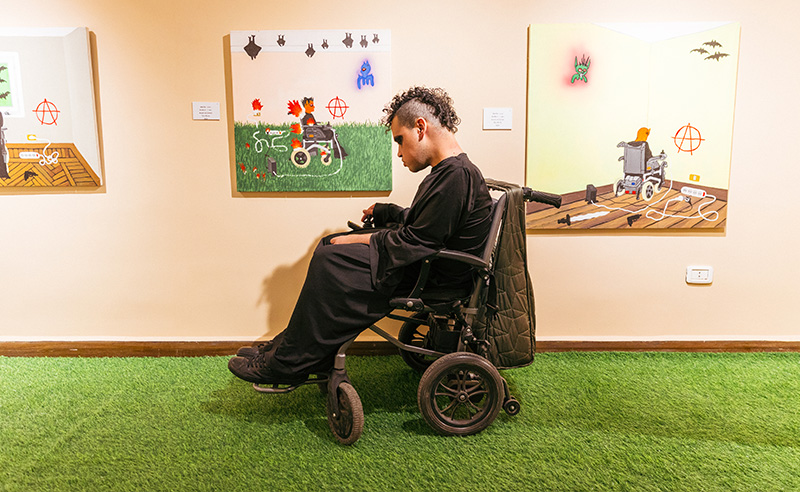Upon entering the “Empty Rooms” exhibition, I am immediately greeted by a crowded open space, where a number of brightly colored paintings catch my eye. Cairo’s hip, grunge, unconventional youth have gathered to celebrate the opening of my friend Omar Sherif’s (stage name Weird) latest exhibition, which explores the theme of disability isolation. Greeted at the exhibition’s entrance by another prominent Cairo contemporary artist, Omar Gabr (who I had no idea I was going to be interviewing, but who urged me to do so: “You must, he’s an interesting guy”), I am introduced to Weird in the inner sanctum of the Zamalek gallery, who talks to me about his work and his identity as an artist.
-91561f4d-0ad7-4b3f-a725-b4bc2077ba17.jpg)
“This exhibition is an expression of my identity, Weird, and the isolation that disabled people experience in a world that tries to exclude them from everyday life, society and general interaction,” Weird told Cairo Scene. The works themselves are spectacular, eye-catching and uniquely self-expressive. The bright colors mask darker themes of loneliness, absurdity and rebellion, as can be seen in the signs of anarchism scattered throughout the works in the exhibition. Apart from the opulent, bourgeois exhibitions that are so common in Zamalek galleries, “Empty Rooms” is decidedly more accessible and welcoming; an invitation to a marginalized community.
-295a1e3c-4ccf-42f3-9bed-9ee0f064f31c.jpg)
Omar Sherif’s work expresses his identity as a disabled person through his paintings, reflecting his life with Duchenne muscular dystrophy since the age of nine, which has since forced him into a wheelchair due to his illness. The artist is heavily influenced by 1980s Neo-Expressionism, particularly American-Caribbean artist Jean-Michel Basquiat. “While I have been inspired by many artists and their focus on authentically expressing their identity however they see fit, I felt it was essential that my art be my own and truly represent my personal journey and struggles,” says Weird. “Subsequently, my dedication to developing my own artistic identity led to the development of Weird’s identity as an artist.”
-588d5dfa-2bc9-4ee8-9877-df6f6fce692f.jpg)
The open-plan installation is reminiscent of a childhood bedroom. The soft, brightly coloured walls are adorned with Weird’s paintings, dotted with figurines including a devil, a wheelchair and an old box-set TV screen, while metal music plays in the background. Many of the paintings on display in “Empty Rooms” depict disabled people in wheelchairs isolated in their homes, a direct expression of the artist’s struggle with his fate. “The exhibition reflects the isolation felt by all people with disabilities. For us, isolation is often a self-defence mechanism against a world that can be very cruel to us. But this tendency to isolate ourselves can also lead to self-sabotage, making the situation even more depressing and distancing us from friends and loved ones,” says Weird.
-c7f4cc04-4d50-4b52-a75d-984210008d35.jpg)
The style, themes and figures used in Weird’s work are outlandish in the Egyptian contemporary art world. The sometimes demonic and often extremely sinister figures – bats, cats and Kalashnikov rifles – represent the artist’s own personal struggle with the establishment. When asked about the ever-present symbol of the letter “A” in a red circle, a common graffiti sign of the anarchist movement, Weird explains: “The anarchist sign dates back decades and has been a timeless symbol of the oppressed. It represents the acceptance and adoption of unorthodoxy and rebellion against prevailing societal norms and the views of the establishment. It is essentially a symbol of doing what you want to do and expressing your true self.”
-ec3eda0c-6d66-4559-b9af-6891c3efdb97.jpg)
The exhibition’s title, “Empty Room,” refers to the lonely hours disabled people spend in their rooms in a world that doesn’t fully cater to their needs: “Even as late as the 1960s, universities and other prestigious institutions were barring disabled people from their doors. Even today, venues and institutions don’t practically cater for disabled people, forcing us to retreat and making socializing a privilege,” Wiard explains.
-6c828a92-a511-4d13-9559-0439405c4f4a.jpg)
The absurd moans of metallic music filled the air, and the crowd of young people who had gathered to support the artist’s opening night had grown by the time I left. The exhibition set-up reflected the emptiness that disabled people may experience in their personal “empty rooms”. WeirDo’s art, a glimpse into a way of life that is sometimes absurd and incomprehensible to able-bodied people, directly expresses the artist’s rebellious spirit against a world that excludes and isolates those deemed unorthodoxly acceptable. It is a particularly important addition to the Egyptian contemporary art world, a homage to the sense of anarchy and isolation felt by countless Egyptian youth for a variety of reasons, especially but not exclusively by disabled people.
-f4fad996-1f27-480f-ad70-7cf5764e359d.png)
“Empty Rooms” will be on display at the Ubuntu Art Gallery in Zamalek until June 13, 2024.

